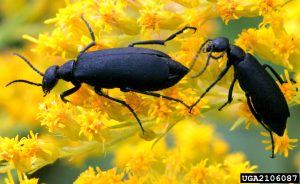The great blister beetle mystery
Views: 6866

We have a blister beetle mystery. A friend purchased a bale of alfalfa hay, and it seems there were blister beetles in it because they are crawling within the rabbit house where she put it to use. The question is how they overwintered within the bale, and what she can do about them.
Blister Beetles
Blister beetles are bothersome in the garden, and potentially deadly to horses and other livestock. According to the University of Arkansas Division of Agriculture, blister beetle poisoning, called cantharidiasis, can happen with cattle, sheep, and poultry, but horses die more readily from it. Feeding contaminated alfalfa hay can kill a horse within 24 hours. Symptoms include blistering around the mouth, as well as a similar result within the intestinal tract. The cantharidin also affects the kidneys. But the question for the blister beetles in the bunny barn remains as how they overwintered in the hay. It’s not unusual for blister beetles to be gathering in the harvesting process, and it’s a significant problem in many parts of the country even if the hay is cured for months.
Since consuming blister beetles on vegetables would cause similar problems in people (although it’s unlikely you would eat enough to kill you), you really don’t want them around anything edible. Granted you will most likely wash your food, but you never know if a crushed beetle could leave behind blistering residue. In the garden, blister beetles arrive in unwelcomed swarms, and if you crush them, whether purposefully or by accident, the irritating substance they secrete as a protective measure can actually blister your skin. Years ago I had them land on my beets, defoliating them before my eyes. Since I was pregnant, I didn’t want to use any pesticides, so I hauled over the Shop Vac and sucked them into oblivion. That did the trick that time, but when they disperse they’re more difficult to manage.
Removal
If you have them on a regular basis, you can spray them with Sevin (carbaryl) or pyrethrin based insecticides on the heavy hitting end, or utilize a more organic spray with Spinosad as its functioning ingredient. To go fully organic, some people sweep them into a bucket of soapy water with a brush of some sort. Wear gloves, and even then, do not touch them. They are known to play dead sometimes falling to the ground and not moving. Yet, they are very much alive and can still irritate your skin. Another option if they are perennially present is to plant trap crops of calendula or amaranth (pig weed) near your favorite vegetables to keep the beetles occupied. Plus, you can vacuum them up easier if they’re on a single crop.
Some Upsides
While I truly don’t want to see them in my garden again, blister beetles are not all bad. There very positive attribute is the larvae consumes grasshopper eggs. Then they will overwinter in the soil before emerging to pupate. After a couple of weeks, the adults are back in action in the hay fields or the garden. Even with them eating grasshopper eggs, you don’t want blister beetles anywhere near your garden. If you have them eliminate them as best as you can and be careful not to touch them.
This terrific shot of a blister beetle was taken by David Cappaert via Bugwood.org.
Meet Amy Grisak
Amy is a freelance author and photographer in Great Falls, MT who specializes in gardening, foods, and sustainable agriculture. She provides information on every kind…
Amy's Recent Posts

Watch for Fungal Diseases on Penstemon








